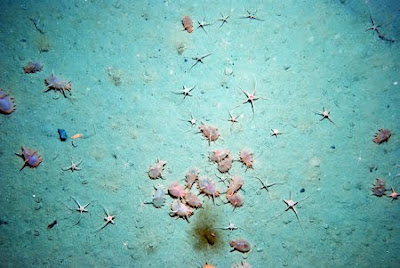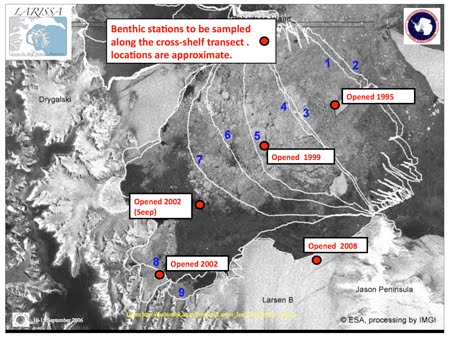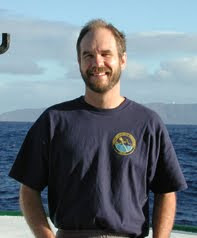We worked our way into the Larsen A Embayment along the Seal Nunataks (mountain peaks protruding above an ice sheet) and then skirted along the 17 m (50 ft) high remnant of the Larsen A Ice Self.

The edge of the Larsen A ice shelf, which extends for 30 miles along Nordenskjold Coast in the Weddell Sea.
This ice shelf forms a vertical wall extending to the horizon, and was as an alluring blue in the evening light. We saw a few seals at the base of the shelf, but otherwise the area was devoid of obvious life – a frozen desert abutting a castle of ice. The Larsen A Shelf retreated more than 30 miles between 1977 and 1995, and has retreated more than 100 miles since 1843, opening new ocean waters to whales, seals and penguins during the Antarctic summer. These recently (in geological time) opened waters will be the focus of much of our research activity, where we will explore how seafloor ecosystems have developed once sunlight reached the overlying sea surface, allowing a productive water-column ecosystem to develop.
After skirting the Larsen A Shelf, we moved into Drygalski Inlet, a bay carved by a huge glacier belching icebergs from the Antarctic ice cap. While in Drygalski Inlet, we were treated to a remarkable Antarctic weather phenomenon – Fohn winds. These are winds that drop moisture and warm up as they blow from west to east over the Antarctic Peninsula, and screeching down onto the ship with speeds of >50 knots and temperatures up to 53 F! It felt positively balmy by Antarctic standards, and we worked on deck in light clothing (sweaters and fleece pants). The warm winds lasted for only a few days before we were rapidly plunged back into truly frigid temperatures. The thermometer dropped from 53 F to 4 F within 8 hours. For the past week, temperatures have remained below 0 F, with wind chill as low as -46 F!
The extreme cold has made work on deck both challenging and fun. Mustaches turn to ice within minutes, and we are all shivering within an hour, even in our warmest clothing. Our sampling gear freezes solid on deck, and those apparatus with moving parts (e.g., the megacorer and our yoyo camera system) must be heated and dried in tents or containers before deployment into the sea. Despite the cold, processing the Blake trawl samples is always fun, even if we have popsicle toes.

Paulo, Jackie, Brendan, Laura and Kim processing a trawl at -40 F wind chill. Are those smiles or grimaces? Probably a little of both!
The most coveted job is shoveling the trawl mud onto the sorting screens because the hard labor of shoveling keeps one warm. Mike is the most exuberant wielder of the shovel!

Mike shoveling mud from the Blake trawl – his eyes are smiling (or maybe just frozen open). We must pass all the mud through the sieve table to collect valuable animals for our food-web and biodiversity studies.
The trawl always brings up extraordinary animals, including sea spiders, sea pigs, and an occasional huge octopus. The sea pigs are particularly amazing, and look like little horned aliens.

Jackie and a new friend – it may be love!
We see the sea pigs (weird deep-sea sea cucumbers with many legs and four horns) aggregated in our seafloor photographs, and have debated what a group sea pigs should be called (the most popular term is a “swaggle of sea pigs”). These “pigs” are remarkable creatures that ingest sediment particles and appear to be some of the first colonists at the seafloor after an ice shelf breaks out.

A swaggle of sea pigs (pink horny balloons) and brittle stars at 686 m depth in Drygalski Inlet. The sea pigs are about 10 cm (4 inches) long and are consuming food-rich particles, or “phytodetritus” from the sediment surface.

Craig and Pavica with huge octopus collected in the trawl. This specimen weighed about 15 kilos and was in excellent condition. After photographing the octopus, we released it back into the Weddell Sea.
Now, after 10 continuous days of 12 hour shifts, we are making our way northwards out of the Larsen A Embayment into the Prince Gustav Channel. We have completed four intensive benthic stations, and we now have a day or two of light work, allowing us to take some recreation in the form of the LARISSA Foosball tournament. The prize for the winners will be ………………………………………………………………..….. first dibs on shoveling trawl mud on the frigid back deck!!!




